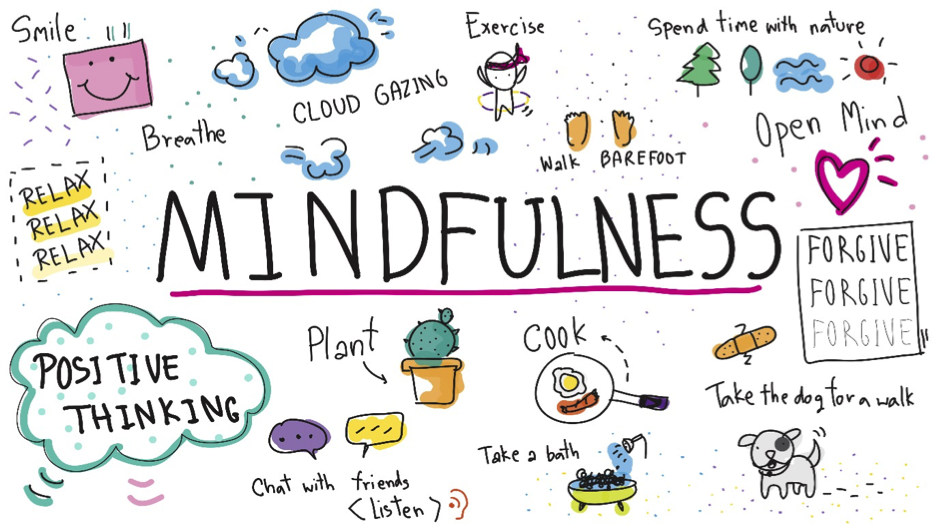
Mindfulness is a hot topic. On Amazon alone there are over 50,000 results for mindfulness books and workplaces across the world are embracing Mindful Mondays. But what is mindfulness and why is it so great?
Mindfulness is, according to mindful.org, ‘the basic human ability to be fully present, aware of where we are and what we’re doing, and not overly reactive or overwhelmed by what’s going on around us’. It’s all about teaching the mind to live in the present so that we can live happier, simpler lives. This is done through meditation and can be achieved in as little as a couple of minutes each day.
The benefits of mindfulness
Mindfulness-based meditation has been linked to a whole host of physical and mental health benefits, including enhanced wellbeing, reduced stress levels, anxiety and depression, lower blood pressure and decreased risk of heart disease.
The NHS has even praised mindfulness meditation for enabling us to ‘enjoy life more and understand ourselves better’. This is because being mindful allows us to reconnect with our bodies and the world around us, something that we don’t do enough of in our busy lives.
Our minds are often so consumed by what’s ahead of us or what has happened in the past, that we are absent from the now.
Mindfulness is an antidote to all the noise inside our heads – it gives us a greater perspective on life and allows us to be in the moment, at one with our bodies and the world we live in. It’s no wonder then that millions of people across the globe love mindfulness.
If you want to feel the benefits for yourself, then you’re in the right place. We’re going to talk through the key principles and techniques of mindfulness, and offer tips on how to embrace mindfulness-based meditation, so that you can start working towards a happier and healthier you.

Find a quiet, comfy spot
With experience, you won’t need to be somewhere quiet in order to be mindful; however, it is easier as a beginner to practise somewhere quiet so that you can focus your full attention on the exercise whilst you get used to it.
This also reduces the likelihood of being disturbed. There is nothing worse than relaxing and then being interrupted by your phone ringing or people’s conversations.
Remember to also sit or lie down somewhere where you’ll be comfortable. You’ll be in the same position for up to 20 minutes, so it’s important that your back is supported and that whatever position you choose enables you to strike a balance of relaxation and focus.

And breathe…
The breath is central to mindfulness. That’s why every mindfulness session begins by taking a deep breath in through the nose and out through the mouth.
Breathing in this way makes you feel as though you’re letting go of the day with every outbreath and creating space in the mind. It also steadies the rhythm of your breathing, which is essential to relaxation; deep breathing slows your heart rate and relaxes your muscles, creating a calming effect.
But this isn’t the only reason for focusing on the breath. Paying attention to, and being aware of, the breath enables you to connect with your body and understand its emotional state. This is because the physical sensation of the breath reflects our thoughts and feelings.
For example, if you’re stressed, you may feel that your breathing is laboured or irregular. That’s why it’s important to note whether your breathing is initially deep or shallow, your breaths long or short, so that you can understand the emotions and feelings that you’re beginning the session with.

To follow the breath, you may find it easier to place your hand on your stomach, or wherever you feel the breath strongest, to really root yourself in the movement of the breath throughout the body.
Repeat these deep breaths for around 8 – 10 cycles and, if you want to, close your eyes on the last outbreath. It’s also important to notice how the body expands with each inhalation and how your muscles soften with every exhalation. Which brings us nicely to our next point…
Remember your senses
It’s time to awaken your senses! How does your body feel? Are there any areas of discomfort or tension? Mentally scan your body from head to toe (a technique called ‘body scan’) and note how different parts of your body feel.
Maybe it’s the contact between your body and the floor beneath you, or the weight of your arms and legs resting on the body? Whatever sensation you feel, you don’t need to do anything about it or change it, just acknowledge it, let the thought pass and then refocus your attention on the breath.
This process also applies to the space around you. What can you smell, feel and hear? Is there a sense of movement or stillness? Be careful not to overthink this though. If you’re straining to hear a certain noise then you’re distracting your mind from the exercise. Let sounds and smells come to you, note them and bring your attention back to the rising and falling sensation of the breath.
Awareness of your senses will ground you in the present moment and create harmony between your mind, body and environment. This all helps to create space in the mind, leaving you refreshed and more alert and with a greater sense of fulfilment and happiness.
Why is this? Because you’re ‘being’ rather than ‘doing’, giving your mind some much needed rest.

Don’t hold back
It’s important to let any negative thoughts surface, even if you are reluctant to do so, as it’s integral to the mindfulness process. By becoming aware of any underlying tension or negativity that has accumulated over the day, you have control of it.
You can control whether or not these thoughts consume your mind and prevent you from living in the moment. Therefore, don’t resist thoughts, watch them come and go like cars on a motorway. Acknowledge each thought but do not interact with it – simply let them go and keep focusing on the breath.
This removes all the ‘noise’ from inside our heads, which will leave you feeling calmer and happier after the exercise. If you do find your mind wandering or lingering on specific thoughts, gently refocus your mind on the breath to ground yourself in your body and in the present once more.
You can do this by counting your breaths: 1 with the inbreath and 2 with the outbreath, up until the count of 10. Repeat this cycle for however long it takes to restore your inner peace.
Download some tools
Practising meditation is often easier when you have a guide. For example, you could attend a local mindfulness group or follow a guided meditation on YouTube.
However, many people opt for the convenience of mobile/tablet apps as they allow you to have mindful moments whenever and wherever you want.
Here are 3 of the best mindfulness apps that will get you started on your meditation journey for free:
Headspace (Guided Meditation)
Created to teach people the art of meditation through fun animations in just a few minutes each day, there are over 350 hours worth of meditations to choose from. You can pick sessions that focus on specific environments, emotions or activities throughout the day, such as work, home or sleep. There are even SOS sessions for those particularly stressful moments (e.g. when you’re burnt out or frustrated). Headspace’s basics pack is free and teaches the fundamentals of mindfulness, so it’s perfect for beginners. Unlimited access to all content costs £5.99/month.
Calm (Sleep and Relaxation)
Apple’s App of the Year 2017, includes over 100 meditations and music tracks for sleep and relaxation to keep you calm and content 24/7. An added bonus of this app is that it features Sleep Stories, which are essentially bedtime stories for adults, read to you by well-loved celebrities and personalities. There are even video lessons on mindful body movement and gentle stretching, ideal for those that want to be mindful on the move. You can get a 7 day free trial and, after this period, access to all app features costs £35.99 per year.
The Mindfulness App (Meditation)
Designed to make meditation accessible to everyone, this app includes a 5-day guided introduction to mindfulness and personalised sessions to suit your needs. The app sends you reminders and mindful notices to keep you on track to reach your mindfulness goals. With a premium subscription for £7.99/month, you can access over 200 meditations from some of the world’s most influential teachers and complete sessions when you’re offline for ultimate downtime. The app and some of its basic meditations are free to download.
Finally…
Mindfulness is a process, something that you build up over weeks, months, even years. It’s essentially like going to the gym, but rather than working your body, mindfulness trains the mind to become calmer and more rational.
So, try the tips above and build up your practice, starting from 5 minutes a day upwards, until you’re comfortable with the exercise. Most importantly, see what works best for you. Not every mindfulness session needs to feature the above techniques and your needs may vary from day to day.
But, hopefully this post has given you an insight into how you can begin your own mindful journey today. If you’ve already given mindfulness a go, or even tried one of the apps above, please let us know what you think in the comments below!

If you want to delve deeper into the subject of alternative therapies and meditation, take a look at our mindfulness courses and other related study programmes below:






Leave a Reply